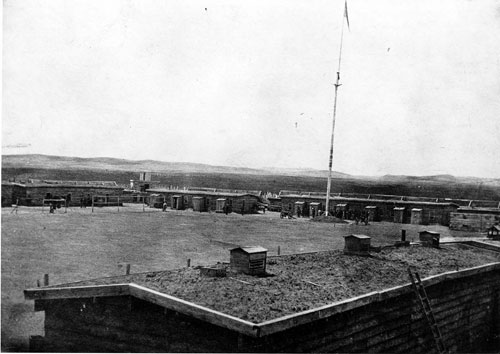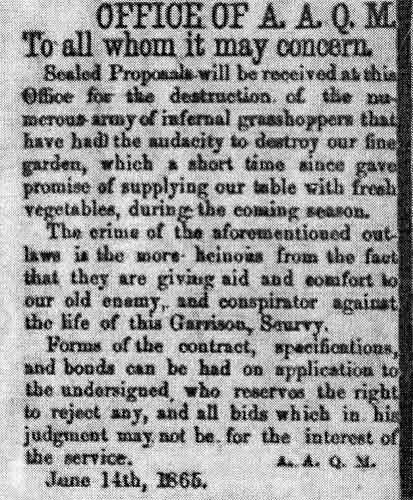Intro | Frontier Scout | Wales | Trobriand | Surgeon Reports | Marsh | Indian Gardens
Reports On Scurvy | "Sanitary" Transciption

Fort Rice was established on the right bank of the Missouri River (Morton County) in 1864 by General Sully during his campaign against the Dakota Sioux. Upstream, near the confluence of the Yellowstone with the Missouri River, soldiers also briefly occupied Fort Union. At Fort Union, Robert Winegar & Ira F.Goodwin began to publish a post newspaper. When the command was transferred to Fort Rice, Capt. E. G. Adams and Lieutenant C. H. Champney took over publication of the newspaper.
The winter of 1864 – 1865 was hard on the soldiers at Fort Rice. No railroad had yet reached Dakota Territory, the river had frozen and no steamboats would come until May, overland transportation was limited to what dogsleds could carry. The usual military diet of foods that could be easily stored and prepared at remote posts was the only source of food to enlisted men. Rations available to soldiers generally consisted of salt beef, salt pork or bacon, hardtack biscuits, bread, and baked beans.
As a result of this poor diet and the long winter isolation of the post, scurvy and other dietary diseases took a heavy toll on the command. Late in the spring, the Frontier Scout printed the names of the men who had died over the past Fall and Winter. By March, scurvy was the leading cause of death, and in April, it was the only cause of death listed.
During the summer of 1865, the soldiers at Fort Rice worked in a post garden. As early as 1818, the War Department ordered remote posts where the Quartermaster was unable to purchase locally grown fresh vegetables for the soldiers’ meals, to raise their own vegetables. However, as the frontier moved west into areas where water was scarce and north where winter cold made for short growing seasons and difficulties in long-term storage, the post gardens did not produce enough to maintain the soldiers’ health.
The other problem was grasshoppers, the scourge of the Great Plains. The June 15, 1865 edition of the Frontier Scout called for “Sealed Proposals” for a plan to combat grasshoppers. Though the notice is written in jest, the problem was a serious one. Grasshoppers could destroy the post garden in a matter of days, leaving the soldiers once again dependent on supplies that could come only by steamboat.
Good weather, and local, wild vegetables supplementing the supplies arriving by steamboat in early May brought recovery to those soldiers still fighting scurvy. On June 22, 1865, the Scout reported that wild onions had greatly improved the health of the post, even though the potatoes brought by steamboat were nearly unfit to eat.
Fort Rice had one of the worst outbreaks of scurvy, but Fort Stevenson also had a bad scurvy season a few years later and other posts had occasional cases of scurvy. By 1870, most Dakota posts had managed to raise vegetables and many had built underground storehouses where potatoes, onions, and other vegetables could be safely kept over the winter.
You can read all of the issues of the Frontier Scout online at http://history.nd.gov/archives/frontierscout.html.
Grasshopper Notice Transcribed:
 OFFICE OF A.A.Q.M.
OFFICE OF A.A.Q.M.
To all whom it may concern.
Sealed Proposals will be received at this Office for the destruction of the numerous army of infernal grasshoppers that have had the audacity to destroy our fine garden, which a short time since gave promise of supplying our table with fresh vegetables, during the coming season.
The crime of the aforementioned outlaws is the more heinous from the fact that they are giving aid and comfort to our old enemy, and conspirator against the life of this Garrison, Scurvy.
Forms of the contract, specifications, and bonds can be had on application to the undersigned, who reserves the right to reject any, and all bids which in his judgment may not be for the interest of the service. A.A.Q.M. June 14th, 1865.
Address:
612 East Boulevard Ave.
Bismarck, North Dakota 58505
Get Directions
Hours:
State Museum and Store: 8 a.m. - 5 p.m. M-F; Sat. & Sun. 10 a.m. - 5 p.m.
We are closed New Year's Day, Easter, Thanksgiving Day, and Christmas Day. We are closed at noon Christmas Eve if it falls on Mon.-Thurs. and are closed all day if it falls on Fri.-Sun.
State Archives: 8 a.m. - 4:30 p.m. M-F, except state holidays; 2nd Sat. of each month, 10 a.m. - 4:30 p.m. Appointments are recommended. To schedule an appointment, please contact us at 701.328.2091 or archives@nd.gov.
State Historical Society offices: 8 a.m. - 5 p.m. M-F, except state holidays.
Contact Us:
phone: 701.328.2666
email: history@nd.gov
Social Media:
See all social media accounts